|
March 2017
Hello, First Name
This email is part of a series intended to share information
and provide facts related to Rogue River fisheries and our management of this
resource. I hope you find this
information both interesting and helpful.
This is an exciting time on the Rogue! A lot of good work is being done to give our
fish the best chance to thrive in a future that looks increasingly chaotic for
natural systems. I hope you will consider giving your time to protect and
restore habitat in the watershed and help grow more fish.
Dan Van Dyke
Rogue District Fish Biologist
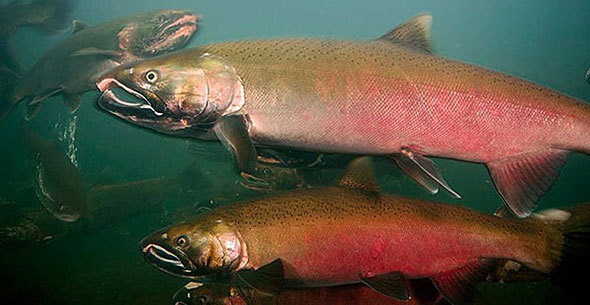 Adult Coho Salmon
Rogue Watershed Spawning Cycle
The spawning cycle continues. Coho Salmon and almost all Summer Steelhead have spawned.
Spring Chinook (Sept-early Oct)
Fall Chinook (Oct-January; spawning later with distance downstream)
Coho Salmon (roughly late November through mid-January)
Summer Steelhead (mid-Dec through mid-March)
Cutthroat trout (similar to summer steelhead)
Winter steelhead (mid-March through June)
Suckers (April)
Pacific Lamprey (roughly April-June)
Coho Salmon Adult Abundance
Every year, the Oregon Department of Fish and Wildlife
(ODFW) estimates abundance of Rogue River Coho Salmon by comparing the number
of unmarked wild Coho to marked hatchery Coho caught at our Huntley Park
seining project on the lower river near Gold Beach. Then when the hatchery run to Cole Rivers
Fish Hatchery is completed, we can produce a very good estimate of the number
of wild Coho returning to the basin to spawn that year. Follow these counts bi-weekly during sampling:
Rogue River fish counts.
Below is a graph of wild Coho numbers since 1980:
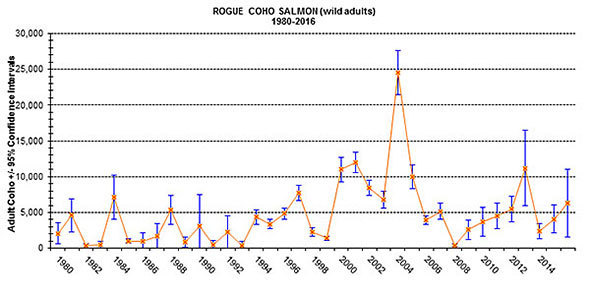 Rogue Coho are unique in Oregon
Rogue River Coho Salmon are part of the Southern Oregon
Northern California Coho (SONCC) populations found at the southern end of Coho
distribution on the West Coast (populations in Oregon Figure 1). Because of
this, they are susceptible to much more extreme weather patterns than are Coho
Salmon in Oregon Coast Coho populations.
The Rogue watershed is naturally much hotter and drier in summer than
the Coquille, Siuslaw and Nehalem watersheds, for instance.
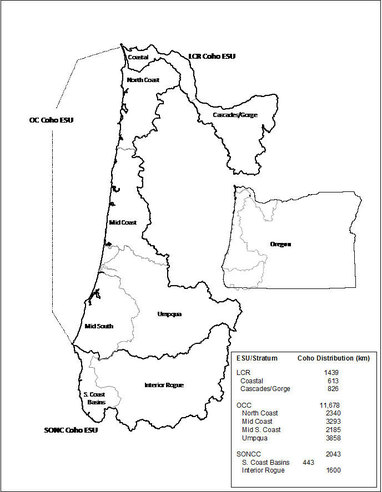 Figure 1: Oregon Coho populations or ESUs (Evolutionary Significant Units). The table gives the length of Coho Salmon rearing distribution in 1st-3rd order streams in each area.
Coho Salmon juvenile surveys
ODFW
has conducted snorkel surveys of headwater streams in the Rogue Basin since 1998.
Examples of these streams include Sucker Creek in the Illinois subbasin, Wolf
Creek in the Grave Creek subbasin, East Fork Williams Creek in the Applegate
subbain, and Neil Creek in the Bear Creek subbasin.
For
stream sites sampled in 2016, 32 percent had juvenile Coho and there were 0.06
juvenile Coho/square meter of pool habitat. Coho occupancy on Rogue survey streams
has ranged from 28 to 84 percent since 1998, and excellent fish numbers will
result in 0.7 juveniles per square meter.
The
full report, and prior years monitoring, can be viewed here.
What does that mean?
Because juvenile Coho typically spend a year in freshwater
prior to entering the ocean, instream rearing conditions are a major factor in Coho
production. Different from most of
coastal Oregon, summer rearing conditions such as warm stream temperatures are
a primary limiting factor for our juvenile Coho in the Interior Rogue,
Applegate, and Illinois basins (SONCC). For
Oregon Coastal Coho (OCC) and the coastal SONCC populations the main limiting
factor is habitat complexity and a lack of over-wintering rearing habitat.
An expert panel convened by ODFW identified the
primary limiting factors affecting Rogue Coho, and this report can be viewed here.
 Shade helps to keep stream temperatures cool in the summer.
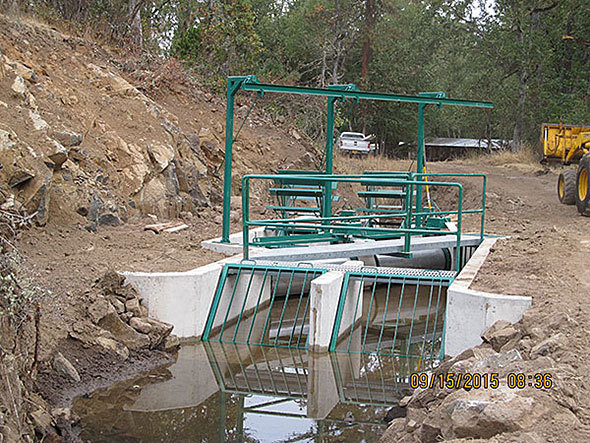 New fish screen at Walcott Diversion on Little Butte Creek
Good projects completed in 2016
ODFW applauds the following habitat projects completed in
the past year that address primary limiting factors for Rogue Coho or help minimize
risk for these fish.
Illinois
- ODFW worked with the United States Forest
Service (USFS) to make repairs to the fish ladder at Illinois Falls. This ladder ensures Coho access above the
falls to 202 miles of spawning habitat over a wide range of flows.
- USFS placed large woody debris (LWD) in upper
East Fork Dunn Creek to improve instream habitat. Large woody debris scours rearing pools in
streams and slows streamflow to allow other habitat features to develop.
- ODFW updated a fish screen on the Seyforth Irrigation
diversion on Sucker Creek and is preparing a new screen for the Floyd diversion
on Althouse Creek. Screens keep juvenile
fish from entering irrigation ditches and ending up on agricultural
fields.
Middle Rogue Applegate population
- The Applegate River Watershed Council (ARWC) is
restoring riparian vegetation on Thompson Creek from the mouth to river mile
five; includes both sides of the stream for at least a quarter mile. Riparian vegetation keeps streams cool,
reduces erosion, and provides food for beavers.
Beaver dams provide good habitat for a variety of species including
fish.
- ODFW installed a new screen on the Beaver Creek
Diversion.
- ARWC acquired passage design grants for culvert
replacement on Butcherknife Creek, dam removal on Palmer Creek (with USFS), and
fish passage at Forest Creek.
Upper Rogue
- The Freshwater Trust (TFT) and Bureau of
Reclamation (BOR) are restoring riparian vegetation on both sides of one mile
of Neil Creek, just south of Ashland.
- ODFW worked with Jackson County Roads to install
baffles on a culvert on Bitterlick Creek (Little Butte) to reduce velocity and
help fish pass upstream. Additional work
is probably needed to address the jump into the culvert.
- ODFW installed a new fish exclusion screen on
the Walcott Irrigation Diversion on Little Butte Creek.
- Work continues on habitat projects within the
Elk Creek watershed near Trail, OR.
Partners include Bureau of Land Management, USFS, Rogue River Watershed
Council, and ODFW.
- TFT and BOR worked with private landowners and
are restoring riparian vegetation (and placing large woody debris) along the
South Fork Little Butte just upstream of Lake Creek, OR.
El Ninos, drought, and fish numbers
Instream habitat restoration is key to “raising the bar” for
salmon and steelhead abundance.
Populations of salmon and steelhead will always rise and fall over time;
however, habitat restoration will not only produce higher highs but also higher
lows.
The Rogue experienced extreme conditions for fish during the
multi-year drought of 2013-2015. In
addition, the ocean experienced one of the stronger El Ninos on record in 2015-2016. El Nino conditions can dictate the quality of
ocean rearing habitat that juvenile fish encounter at sea. The food supply is greatly reduced in
quantity and quality.
For people who work and care for Rogue fish, we need to
remember to look back to previous extremes to help track our progress. The last multi-year drought combined with a
very strong El Nino took place in the late 1980s through early 1990s (El Nino
of 1991-1992).
Below is a graph of Coho adult abundance two years before,
during and two years after the ‘91-92 El Nino, and a graph from two years
before and during the ‘15-16 El Nino.
Two more years of data for the most recent El Nino are needed, but
returns to date are encouraging.
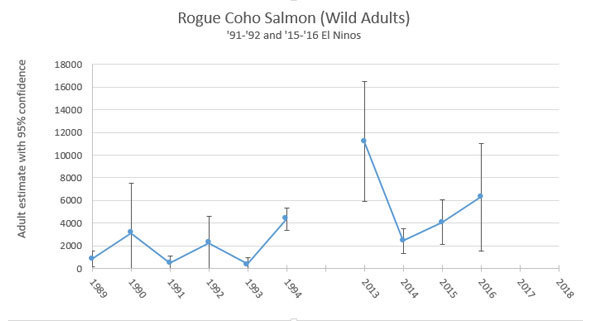
|